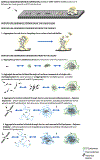The biofilm life cycle: expanding the conceptual model of biofilm formation
- PMID: 35922483
- PMCID: PMC9841534
- DOI: 10.1038/s41579-022-00767-0
The biofilm life cycle: expanding the conceptual model of biofilm formation
Abstract
Bacterial biofilms are often defined as communities of surface-attached bacteria and are typically depicted with a classic mushroom-shaped structure characteristic of Pseudomonas aeruginosa. However, it has become evident that this is not how all biofilms develop, especially in vivo, in clinical and industrial settings, and in the environment, where biofilms often are observed as non-surface-attached aggregates. In this Review, we describe the origin of the current five-step biofilm development model and why it fails to capture many aspects of bacterial biofilm physiology. We aim to present a simplistic developmental model for biofilm formation that is flexible enough to include all the diverse scenarios and microenvironments where biofilms are formed. With this new expanded, inclusive model, we hereby introduce a common platform for developing an understanding of biofilms and anti-biofilm strategies that can be tailored to the microenvironment under investigation.
© 2022. Springer Nature Limited.
Figures





References
-
- Costerton JW, Geesey GG, Cheng KJ. How bacteria stick. Sci Am. 1978;238(1):86–95. - PubMed
-
- McCoy WF, Bryers JD, Robbins J, Costerton JW. Observations of fouling biofilm formation. Can J Microbiol. 1981;27(9):910–7. - PubMed
-
- Hoiby N, Bjarnsholt T, Moser C, Bassi GL, Coenye T, Donelli G, et al. ESCMID guideline for the diagnosis and treatment of biofilm infections 2014. Clin Microbiol Infect. 2015;21 Suppl 1:S1–25. - PubMed
Publication types
MeSH terms
Grants and funding
LinkOut - more resources
Full Text Sources

